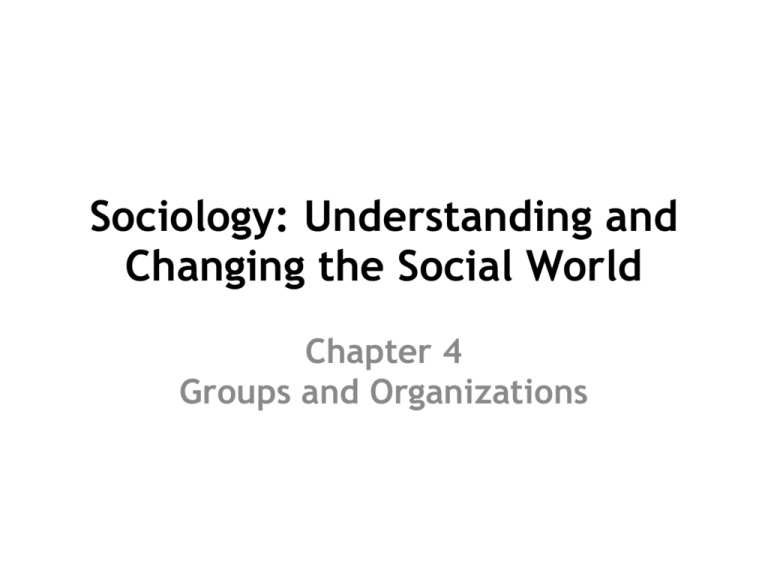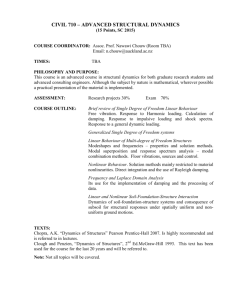SOC114 Ch04 - WordPress.com
advertisement

Sociology: Understanding and Changing the Social World Chapter 4 Groups and Organizations Learning Objectives • Describe how a social group differs from a social category or social aggregate • Distinguish a primary group from a secondary group • Define a reference group and provide one example of such a group • Explain the importance of networks in a modern society • Explain how and why group dynamics change as groups grow in size Learning Objectives • Describe the different types of leaders and leadership styles • Be familiar with experimental evidence on group conformity • Explain how groupthink develops and why its development may lead to negative consequences • Describe the three types of formal organizations • List the defining characteristics of bureaucracies Learning Objectives • Discuss any two disadvantages of bureaucracies • Explain Michels’ iron law of oligarchy • Describe the two ways in which groups and organizations play an important role in social change • Discuss how whistleblowing is relevant to a discussion of groups, organizations, and social change Social Groups • Social group: Two or more people who regularly interact on the basis of mutual expectations and share a common identity • Social category: Collection of individuals who have at least one attribute in common but otherwise don’t necessarily interact • Social aggregate: Collection of people who are in the same place in the same time, but otherwise don’t necessarily interact, except in the most superficial of ways, or have anything else in common Social Groups Primary group • Small in size • Extensive interaction and strong emotional ties • Lasts over time Secondary group • Large in size • More impersonal than a primary group • Exists to achieve a specific purpose Social Groups • Reference group: Sets a standard for guiding our own behavior and attitudes • An example: – Friends act as a reference group in your adolescence — You dress up the way they do • In-group: Members feel particularly loyal and take great pride in belonging • Out-group: Group with which an in-group feels it is competing for various kinds of rewards and compared to which the in-group feels superior Social Groups • Network: The totality of relationships that link us to other people and groups and through them to still other people and groups • Networks are important for: – Getting advice – Borrowing small amounts of money – Finding a job – Receive better medical care Social Groups • Factors affecting our involvement in networks: – Social class – Occupational status – Race – Ethnicity – Gender Group Dynamics and Behavior • Group size is important for: – The functioning of a group – The nature of its members’ attachments – The group’s stability • Dyad — Two person group; the smallest group – Relationships are emotionally intense, but very unstable and short-lived • Triad — Three-person group – Relationships are fairly intense, but it is more stable than a dyad Group Dynamics and Behavior – Advantage of a triad • If two people have a dispute, the third member can help them reach some compromise that will satisfy all the triad members – Disadvantage of a triad • Two of its members can become very close and increasingly disregard the third member Table 4.1 - Number of Two-Person Relationships in Groups of Different Sizes Group Dynamics and Behavior • Types of leaders – Instrumental — Main focus is to achieve group goals and accomplish group tasks – Expressive — Main focus is to maintain and improve the quality of relationships among group members and to ensure group harmony Group Dynamics and Behavior • Types of leadership styles – Authoritarian • Primary focus on achieving group goals and on rigorous compliance with group rules and penalties for noncompliance • Leaders make decisions on their own and tell other group members what to do and how to do it – Democratic • Involves extensive consultation with group members on decisions and less emphasis on rule compliance • Leaders make the final decision, after considering group members opinion Group Dynamics and Behavior – Laissez-faire • The leader more or less sits back and lets the group function on its own and really exerts no leadership role • Less effective than authoritarian and democratic • Authoritarian or democratic leadership? – Group values task accomplishment than how well group members get along and how much they like their leader — Authoritarian leadership – Group members place their highest priority on their satisfaction with decisions and decisionmaking in the group — Democratic leadership Group Dynamics and Behavior • Some small groups shun leadership and operate by consensus – No decision is made unless all group members agree with it – Advantage — Group members feel good about the final decision and about being in the group – Disadvantage — Group’s inability to make quick and efficient decisions • Gender differences in leadership styles – Women — More likely to be democratic leaders – Men — More likely to be authoritarian leaders Group Dynamics and Behavior • Experimental evidence on group conformity: – Solomon Asch and Perceptions of Line Lengths – Stanley Milgram and Electric Shock – The Third Wave – Zimbardo’s Prison Experiment Group Dynamics and Behavior • Groupthink — People go along with the desires and views of a group against their better judgments, because: – They do not want to appear different – They have come to believe that the group’s course of action may be the best one after all • Groupthink can have negative consequences because the group members quickly agree on some course of action without thinking completely of alternatives Group Dynamics and Behavior • Types of formal organizations – Utilitarian — Provides an income or some other personal benefit • Examples — Business organizations, colleges, and universities – Normative — Allows people to pursue their moral goals and commitments; members do not get paid instead they contribute • Examples — Churches and synagogues, Boy and Girl Scouts, and the Kiwanis Club – Coercive — Seeks to control all phases of their members’ lives • Examples — Prisons and state mental institutions Group Dynamics and Behavior • Key aspects of bureaucracies – Specialization – Hierarchy – Written rules and regulations – Impartiality and impersonality – Record-keeping Group Dynamics and Behavior • Disadvantages of bureaucracy – Impersonality and alienation – Red tape – Trained incapacity – Bureaucratic incompetence – Goal displacement and self-perpetuation Group Dynamics and Behavior • Michels’ iron law of oligarchy – Large organizations inevitably develop an oligarchy, or the undemocratic rule of many people by just a few people – Leaders increasingly monopolize knowledge because they have more access than other organizational members to information and technology – Leaders begin to think they are better suited than other people to lead their organizations, and also do their best to stay in their positions of power, which they find very appealing Groups, Organizations, and Social Change • Two ways in which groups and organizations play an important role in social change: – Social reform – Maintaining the status quo Groups, Organizations, and Social Change • Whistleblowing — Raising concerns involving illegal and/or potentially harmful behavior • It is not easy to be a whistleblower — Several whistleblowers have been harassed, fired, or sued • Various federal and state laws have been passed to protect whistleblowers






